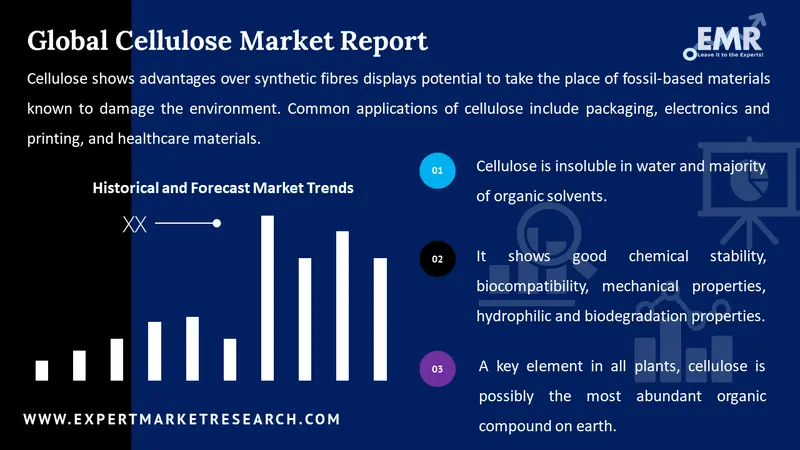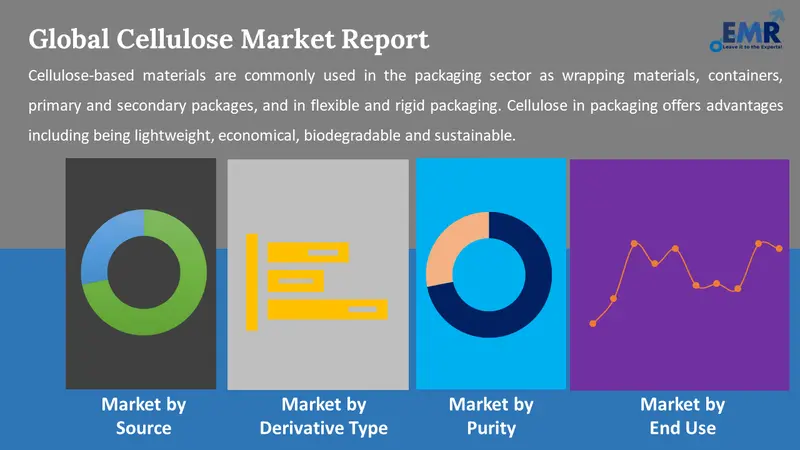
Consumer Insights
Uncover trends and behaviors shaping consumer choices today
Procurement Insights
Optimize your sourcing strategy with key market data
Industry Stats
Stay ahead with the latest trends and market analysis.
Trending Now



Base Year
Historical Year
Forecast Year






The global cellulose market is expected to grow at a CAGR of 4.1% during the period 2025-2034. Cellulosic materials have several applications in thermo-reversible and tenable hydrogels, coating additives, paper making, flexible screens, food packaging, optically transparent films and lightweight materials for ballistic protection, automobile windows, etc. North America, Europe and Asia are expected to be key markets.

Read more about this report - REQUEST FREE SAMPLE COPY IN PDF
Cellulose shows advantages over synthetic fibres displays potential to take the place of fossil-based materials known to damage the environment. Common applications of cellulose include packaging, electronics and printing, and healthcare materials. A key element in all plants, cellulose is possibly the most abundant organic compound on earth. While cellulose is present in all parts of a plant, it varies in content from part to part; for example, it is present in higher quantities in a plant’s stem than in leaves. Other sources of cellulose include wood, annual crops, residual agricultural waste, marine animals (tunicates), algae, fungi, bacteria, invertebrates and amoeba.
Cellulose is insoluble in water and majority of organic solvents. It shows good chemical stability, biocompatibility, mechanical properties, hydrophilic and biodegradation properties. The structural and physical properties of cellulose have drawn significant attention for multiple applications, including films, packaging, paper, building and coating materials, advanced materials, food, drugs and flexible electronics. Nanocrystalline cellulose (also known as cellulose nanocrystals), nanofibrillated cellulose (or cellulose nanofibrils), bacterial cellulose and cellulose nanobeads are the four types of cellulose in the nano-range Microcrystalline cellulose (a kind of commercially available cellulose) has applications in pharmaceuticals and the food industry; it is also used as starting material to manufacture nanocellulose.
In this day and age, with environmental issues and circular economy gaining much attention, significant efforts are being made towards innovative applications employing natural fibres. Cellulose may have an important role in such applications. One such application is extraction of cellulose from wastepaper which is a probable source of cellulose. However, recycling wastepaper results in shorter fibre length, giving lower grade paper. Nevertheless, cellulose thus obtained from wastepaper could be employed in multiple applications. Cellulose nanocrystals extracted from wastepaper is suitable for food packaging applications.
Cellulose-based materials are commonly used in the packaging sector as wrapping materials, containers, primary and secondary packages, and in flexible and rigid packaging. Cellulose in packaging offers advantages including being lightweight, economical, biodegradable and sustainable. Cellulose fibres can be obtained from agricultural waste to manufacture biodegradable composites with good mechanical properties for packaging.
Carboxymethyl cellulose is used for regulated drug release in nanocomposite applications.
Companies offer key applications of cellulose-based materials. For example, Daicel introduces major applications of cellulose acetate, including Tri-acetyl cellulose or cellulose triacetate (TAC) film, cellulose acetate plastics, cosmetics and healthcare, membranes for water treatment, acetate fibres, film base for photographic films, etc.
Cellulose triacetate is used in optical films such as protective films for LCD polarizing panels employed in LCD TVs, mobile phones, and notebook computers. Cellulose acetate also shows significant potential in light of advances in optical imaging technology.
Natural cellulose (such as cotton linter and wood pulp) is used to produce cellulose acetate plastics, making the sheets gentle on the skin and less allergenic. As compared to petroleum-based resins, the sheets are more transparent, enabling the expression of vivid colours. Further, processed parts manufactured with the material are easy to polish, cut as bend and twist as it begins to deform at around 60 0C, rendering it appropriate for processing the unique curves of eyeglass frames.
Cellulose acetate is gentle to humans and the environment; it exhibits smooth texture and good spreadability, and is used in cosmetics and healthcare products.
The surface of cellulose acetate membranes with outstanding hydrophilicity are resistant to dirt, and can maintain high permeability with stability. The "Cellulose acetate hollow fiber ultrafiltration membrane module" has been taken up by several water purification plants, and enables high-quality drinking water.
Acetate fibre textile has a silky lustre and feel, displays superior water absorption and hygroscopicity, and offers an optimum material for comfortable clothing. Additionally, acetate tow, a mesh structure comprising acetate fibres, is used in cigarette filters.
Cellulose acetate is suitable as a base film for photographic and X-ray films due to outstanding transparency and surface smoothness.

Read more about this report - REQUEST FREE SAMPLE COPY IN PDF
By source, the market is segmented into:
By derivative type, the market is classified into:
By purity, the market is divided into:
By end use, the market is classified into:
By region, the market is segmented into:
The report presents a detailed analysis of the following key players in the market, looking into their capacity, and latest developments like capacity expansions, plant turnarounds, and mergers and acquisitions:
The EMR report gives an in-depth insight into the industry by providing a SWOT analysis as well as an analysis of Porter’s Five Forces model.
| REPORT FEATURES | DETAILS |
| Base Year | 2023 |
| Historical Period | 2018-2024 |
| Forecast Period | 2025-2034 |
| Scope of the Report |
Historical and Forecast Trends, Industry Drivers and Constraints, Historical and Forecast Market Analysis by Segment:
|
| Breakup by Source |
|
| Breakup by Derivative Type |
|
| Breakup by Purity |
|
| Breakup by End Use |
|
| Breakup by Region |
|
| Market Dynamics |
|
| Trade Data Analysis |
|
| Price Analysis |
|
| Competitive Landscape |
|
| Companies Covered |
|
| Report Price and Purchase Option | Explore our purchase options that are best suited to your resources and industry needs. |
| Delivery Format | Delivered as an attached PDF and Excel through email, with an option of receiving an editable PPT, according to the purchase option. |
*While we strive to always give you current and accurate information, the numbers depicted on the website are indicative and may differ from the actual numbers in the main report. At Expert Market Research, we aim to bring you the latest insights and trends in the market. Using our analyses and forecasts, stakeholders can understand the market dynamics, navigate challenges, and capitalize on opportunities to make data-driven strategic decisions.*
Get in touch with us for a customized solution tailored to your unique requirements and save upto 35%!
The global cellulose market is projected to grow at a CAGR of 4.1% between 2025 and 2034.
The major drivers of the market include the increasing adoption of the cellulose fibre in textile industry, rising disposable income, rising standard of living, improvements in the education system and the growing demand for printed books across developing countries.
Rising applications across various sectors and rising paper production are the key industry trends propelling the market's growth.
The major regions in the industry are North America, Latin America, the Middle East and Africa, Europe, and the Asia Pacific.
The sources are natural and synthetic. Natural is further broken down into crops, fruits, and tree wood.
Based on derivative type, the market is divided into commodity cellulose pulp, cellulose fibres, cellulose ethers, cellulose esters, microcrystalline cellulose, and nanocellulose, among others.
On the basis of purity, the market is divided into above 95%, 85%- 95%, and below 85%.
The end-uses are food, pharmaceuticals, paper and pulp, cosmetics, and textile, among others.
The major players in the industry are International Flavors & Fragrances Inc. (Dupont De Nemours, Inc.), Eastman Chemical Company, Daicel Corporation, MACHEREY-NAGEL GmbH & Co. KG, and Celanese Corporation, among others.
Datasheet
One User
USD 2,499
USD 2,249
tax inclusive*
Single User License
One User
USD 3,999
USD 3,599
tax inclusive*
Five User License
Five User
USD 4,999
USD 4,249
tax inclusive*
Corporate License
Unlimited Users
USD 5,999
USD 5,099
tax inclusive*
*Please note that the prices mentioned below are starting prices for each bundle type. Kindly contact our team for further details.*
Flash Bundle
Small Business Bundle
Growth Bundle
Enterprise Bundle
*Please note that the prices mentioned below are starting prices for each bundle type. Kindly contact our team for further details.*
Flash Bundle
Number of Reports: 3
20%
tax inclusive*
Small Business Bundle
Number of Reports: 5
25%
tax inclusive*
Growth Bundle
Number of Reports: 8
30%
tax inclusive*
Enterprise Bundle
Number of Reports: 10
35%
tax inclusive*
How To Order
Our step-by-step guide will help you select, purchase, and access your reports swiftly, ensuring you get the information that drives your decisions, right when you need it.

Select License Type
Choose the right license for your needs and access rights.

Click on ‘Buy Now’
Add the report to your cart with one click and proceed to register.

Select Mode of Payment
Choose a payment option for a secure checkout. You will be redirected accordingly.
Gain insights to stay ahead and seize opportunities.

Get insights & trends for a competitive edge.

Track prices with detailed trend reports.

Analyse trade data for supply chain insights.

Leverage cost reports for smart savings

Enhance supply chain with partnerships.

Connect For More Information
Our expert team of analysts will offer full support and resolve any queries regarding the report, before and after the purchase.
Our expert team of analysts will offer full support and resolve any queries regarding the report, before and after the purchase.
We employ meticulous research methods, blending advanced analytics and expert insights to deliver accurate, actionable industry intelligence, staying ahead of competitors.
Our skilled analysts offer unparalleled competitive advantage with detailed insights on current and emerging markets, ensuring your strategic edge.
We offer an in-depth yet simplified presentation of industry insights and analysis to meet your specific requirements effectively.



Australia
63 Fiona Drive, Tamworth, NSW
+61-448-061-727
India
C130 Sector 2 Noida, Uttar Pradesh 201301
+91-723-689-1189
Philippines
40th Floor, PBCom Tower, 6795 Ayala Avenue Cor V.A Rufino St. Makati City,1226.
+63-287-899-028, +63-967-048-3306
United Kingdom
6 Gardner Place, Becketts Close, Feltham TW14 0BX, Greater London
+44-753-713-2163
United States
30 North Gould Street, Sheridan, WY 82801
+1-415-325-5166
Vietnam
193/26/4 St.no.6, Ward Binh Hung Hoa, Binh Tan District, Ho Chi Minh City
+84-865-399-124
United States (Head Office)
30 North Gould Street, Sheridan, WY 82801
+1-415-325-5166
Australia
63 Fiona Drive, Tamworth, NSW
+61-448-061-727
India
C130 Sector 2 Noida, Uttar Pradesh 201301
+91-723-689-1189
Philippines
40th Floor, PBCom Tower, 6795 Ayala Avenue Cor V.A Rufino St. Makati City, 1226.
+63-287-899-028, +63-967-048-3306
United Kingdom
6 Gardner Place, Becketts Close, Feltham TW14 0BX, Greater London
+44-753-713-2163
Vietnam
193/26/4 St.no.6, Ward Binh Hung Hoa, Binh Tan District, Ho Chi Minh City
+84-865-399-124
Share